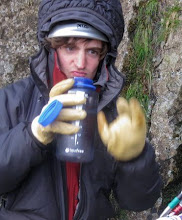Today brought a visit to Sakurajima, across the strait from the city of Kagoshima - something I've really been looking forward to. I wasn't disappointed, that's for sure.
Some background information. "Sakurajima" means "cherry blossom island". I'm not sure on the cherry blossom part, but it did used to be an island. I say 'did', because it is an active volcano, and in 1914 it erupted so violently and erupted so much lava that it joined itself to the mainland. It's still active, frequently scattering surrounding areas (including Kagoshima) with ash, and providing enough of a threat that all surrounding areas have evacuation plans and drills. It doesn't stop people living on the 'island', however. The children just were hard hats when they go to school.
Anyway, I should probably post some photos...

This is the view from the ferris wheel in Kagoshima. That's a ferris wheel in front of an active volcano, which probably isn't a great idea, but I rode it anyway. You can see how close the city of Kagoshima is to the volcano.

Taken from the ferry on the way across the strait at about midday.

The view I had from the east of the mountain, from the point I sat and ate my lunch. It seemed to be sporadically throwing up steam and a little ash, but not in huge quantities. The active vent on Minami-dake (the southern peak, since there are actually 3 or 4 included within 'Sakurajima') is basically visible from here.

Close-up of the active vent on Minami-dake.

This 'torii' gate (entrance to a Shinto shrine) was 3m high. It was buried during the enormous 1914 eruption, but the top was left sticking out.

View from a lava field trail near the visitor centre. The volcano seemed to become more active at about this time, and began spewing quite a lot of ash as well as steam. Note the ash falling on the flank of the mountain (it looks like dark rain bands).

Another shot taken a few minutes later, showing the growth of the eruption column.

Shot from the ferry on the way back to Kagoshima, showing the extent of the eruption column and ash cloud drifting away from the mountain.
Bear in mind that Sakurajima does this sort of thing ALL THE TIME and this is by no means 'dangerous' unless you are way too close to the summit. The biggest danger you'll face at the moment is that you'll get falling ash in your hair.
Anyway, tomorrow brings with it the excitement of another bus journey to Kumamoto. From there I go to the Aso-san area, one of the world's largest (wait for it) active volcanic calderas, where I have a campsite booked for 2 nights. I just hope the weather holds now!
Until next time!
James
